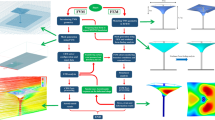Abstract
The market demand on business jets is growing fast. The Blended-Wing-Body (BWB) configuration is adapted to design high-efficient green business jet. Conceptual study of the BWB-type transonic business jet is carried out. The BWB-type business jet expected to provide a better cabin space and aerodynamic performance to compare with the conventional business jet. An aerodynamic analysis of the BWB-type transonic business jet is performed to understand the flow field around the aircraft at a high subsonic flight speed. The commercial CFD (Computational Fluid Dynamics) code, ANSYS Fluent, is used for aerodynamic analysis. A parametric study is carried out to analyze the relation between the design parameters and aerodynamic characteristics. The commercial PIDO (Process Integration and Design Optimization) tool, PIAnO, is used to perform a parametric study. As a result of parametric study, the sensitivity of the design parameters is analyzed and a proportion of aerodynamic influence of each design parameter is presented. One of the sample design configurations for detailed aerodynamic analysis is selected. As a result of the aerodynamic analysis, aerodynamic coefficients and pressure coefficient distribution around the BWB-type business jet are presented. Increase of AOA and Mach number produces stronger shock and drag coefficient is increased due to wave drag.



















Similar content being viewed by others
References
“Market Forecast 2013-2032” (2013) Bombardier aerospace
Potsdam MA (1997) Blended wing body analysis and design. AIAA Appl Aerodyn Conf 799–805
Liebeck RH, Page MA, Rawdon BK (1998) Blended-wing-body subsonic commercial transport. In: 36th AIAA aerospace sciences meeting and exhibit
Osterheld CM, Heinze W, Horst P (2001) “Preliminary design of a blended wing body configuration using the design tool PrADO. DGLR BERICHT, no. 5, pp 119–128
Qin N, Vavalle A, Le Moigne A, Laban M, Hackett K, Weinerfelt P (2004) Aerodynamic considerations of blended wing body aircraft. Prog Aerosp Sci 40(6):321–343. https://doi.org/10.1016/j.paerosci.2004.08.001
Liebeck RH (2004) Design of the blended wing body subsonic transport. J Aircr 41(1):10–25. https://doi.org/10.2514/1.9084
Qin N, Vavalle A, Le Moigne A (2005) Spanwise lift distribution for blended wing body aircraft. J Aircr 42(2):356–365
Dowling AP, Hynes T (2006) Towards a silent aircraft. Aeronaut J 110(1110):487–494
Hileman JI, Spakovszky ZS, Drela M (2007) Airframe design for silent aircraft. In: 45th AIAA aerospace science meeting and exhibit, Reno, Nevada
Kim HD, Brown GV, Felder JL (2008) Distributed turboelectric propulsion for hybrid wing body aircraft. In: 2008 international powered lift conference, London, UK
Felder J, Kim HD, Brown G (2009) Turboelectric distributed propulsion engine cycle analysis for hybrid wing body aircraft. In: 47th AIAA aerospace science meeting, Orlando, FL
Leifsson L, Ko A, Mason WH, Schetz JA, Grossman B, Haftka RT (2013) Multidisciplinary design optimization of blended-wing-body transport aircraft with distributed propulsion. Aerosp Sci Technol 25(1):16–28
Nara T, Kanazaki M (2010) Initial design and evaluation of a novel concept regional aircraft. In: 2010 Asia-Pacific international symposium on aerospace technology, 2010
Kanazaki M, Hanida R, Nara T, Shibata M, Nomura T, Murayama M, Yamamoto K (2013) Challenge of design exploration for small blended wing body using unstructured flow solver. Comput Fluids 85:71–77
Harijono D, Alvin KLW (2012) Conceptual design and aerodynamic study of blended wing body business jet. In: Proceeding of 28th international congress of the aeronautical sciences, Brisbane, 2012
Mulyanto T, Nurhakim MLI (2013) Conceptual design of blended wing body business jet aircraft. J Kones 20:299–306
PIAnO (Process Integration, Automation and Optimization). User’s manual, version 3, PIDOTECH Inc
Schmitt V, Charpin F (1979) Pressure distributions on the ONERA-M6-wing at transonic mach numbers. In: Experimental data base for computer program assessment, report of the fluid dynamics panel working group 04, AGARD AR 138
Acknowledgements
The authors appreciate PIDOTECH Inc.’s supporting PIAnO software as a PIDO tool for the design of experiments and parametric study.
Author information
Authors and Affiliations
Corresponding author
Rights and permissions
About this article
Cite this article
Choi, H., Cho, J. Aerodynamic Analysis and Parametric Study of the Blended-Wing-Body-Type Business Jet. Int. J. Aeronaut. Space Sci. 20, 335–345 (2019). https://doi.org/10.1007/s42405-018-0121-4
Received:
Revised:
Accepted:
Published:
Issue Date:
DOI: https://doi.org/10.1007/s42405-018-0121-4




